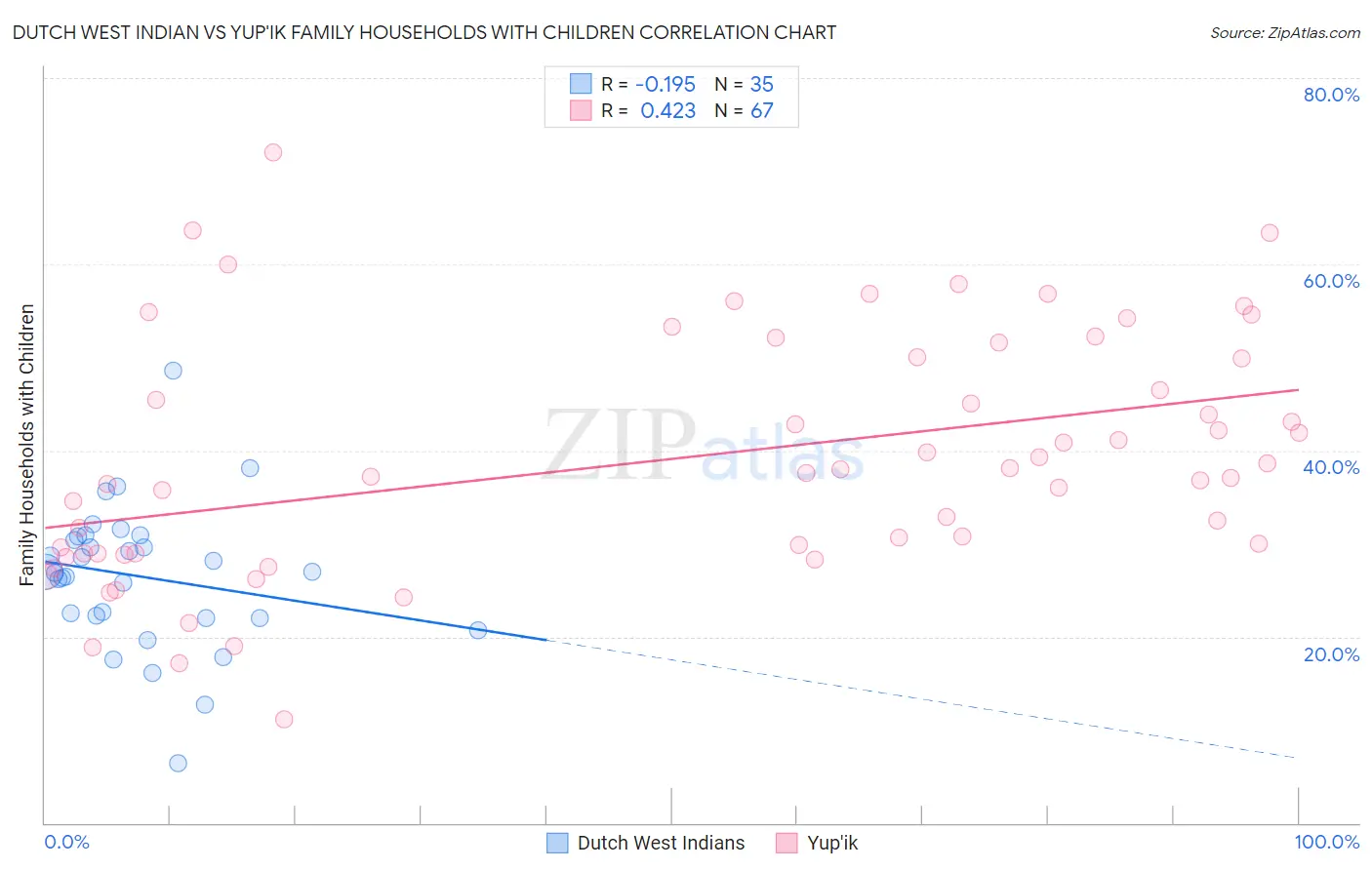Dutch West Indian vs Yup'ik Family Households with Children
COMPARE
Dutch West Indian
Yup'ik
Family Households with Children
Family Households with Children Comparison
Dutch West Indians
Yup'ik
27.2%
FAMILY HOUSEHOLDS WITH CHILDREN
15.8/ 100
METRIC RATING
209th/ 347
METRIC RANK
37.0%
FAMILY HOUSEHOLDS WITH CHILDREN
100/ 100
METRIC RATING
1st/ 347
METRIC RANK
Dutch West Indian vs Yup'ik Family Households with Children Correlation Chart
The statistical analysis conducted on geographies consisting of 85,765,288 people shows a poor negative correlation between the proportion of Dutch West Indians and percentage of family households with children in the United States with a correlation coefficient (R) of -0.195 and weighted average of 27.2%. Similarly, the statistical analysis conducted on geographies consisting of 39,956,617 people shows a moderate positive correlation between the proportion of Yup'ik and percentage of family households with children in the United States with a correlation coefficient (R) of 0.423 and weighted average of 37.0%, a difference of 36.1%.

Family Households with Children Correlation Summary
| Measurement | Dutch West Indian | Yup'ik |
| Minimum | 6.5% | 11.1% |
| Maximum | 48.6% | 72.0% |
| Range | 42.2% | 60.9% |
| Mean | 26.5% | 39.1% |
| Median | 26.9% | 37.6% |
| Interquartile 25% (IQ1) | 22.0% | 28.9% |
| Interquartile 75% (IQ3) | 30.8% | 50.0% |
| Interquartile Range (IQR) | 8.7% | 21.1% |
| Standard Deviation (Sample) | 7.7% | 12.9% |
| Standard Deviation (Population) | 7.5% | 12.8% |
Similar Demographics by Family Households with Children
Demographics Similar to Dutch West Indians by Family Households with Children
In terms of family households with children, the demographic groups most similar to Dutch West Indians are Immigrants from Poland (27.2%, a difference of 0.030%), Immigrants from Ukraine (27.2%, a difference of 0.060%), Welsh (27.2%, a difference of 0.070%), Immigrants from Dominica (27.2%, a difference of 0.080%), and Okinawan (27.2%, a difference of 0.090%).
| Demographics | Rating | Rank | Family Households with Children |
| Americans | 22.8 /100 | #202 | Fair 27.3% |
| Kiowa | 22.2 /100 | #203 | Fair 27.3% |
| Immigrants | Sudan | 21.6 /100 | #204 | Fair 27.3% |
| Immigrants | Haiti | 20.3 /100 | #205 | Fair 27.2% |
| Immigrants | Micronesia | 20.2 /100 | #206 | Fair 27.2% |
| Haitians | 19.8 /100 | #207 | Poor 27.2% |
| Immigrants | Poland | 16.4 /100 | #208 | Poor 27.2% |
| Dutch West Indians | 15.8 /100 | #209 | Poor 27.2% |
| Immigrants | Ukraine | 14.4 /100 | #210 | Poor 27.2% |
| Welsh | 14.2 /100 | #211 | Poor 27.2% |
| Immigrants | Dominica | 13.9 /100 | #212 | Poor 27.2% |
| Okinawans | 13.7 /100 | #213 | Poor 27.2% |
| Africans | 13.0 /100 | #214 | Poor 27.2% |
| Northern Europeans | 12.8 /100 | #215 | Poor 27.2% |
| Cubans | 12.2 /100 | #216 | Poor 27.1% |
Demographics Similar to Yup'ik by Family Households with Children
In terms of family households with children, the demographic groups most similar to Yup'ik are Inupiat (32.8%, a difference of 12.7%), Immigrants from Mexico (31.6%, a difference of 17.1%), Mexican (31.4%, a difference of 18.0%), Tongan (31.2%, a difference of 18.5%), and Immigrants from India (31.0%, a difference of 19.2%).
| Demographics | Rating | Rank | Family Households with Children |
| Yup'ik | 100 /100 | #1 | Exceptional 37.0% |
| Inupiat | 100 /100 | #2 | Exceptional 32.8% |
| Immigrants | Mexico | 100.0 /100 | #3 | Exceptional 31.6% |
| Mexicans | 100.0 /100 | #4 | Exceptional 31.4% |
| Tongans | 100.0 /100 | #5 | Exceptional 31.2% |
| Immigrants | India | 100.0 /100 | #6 | Exceptional 31.0% |
| Immigrants | Central America | 100.0 /100 | #7 | Exceptional 31.0% |
| Yakama | 100.0 /100 | #8 | Exceptional 30.8% |
| Thais | 100.0 /100 | #9 | Exceptional 30.6% |
| Immigrants | Fiji | 100.0 /100 | #10 | Exceptional 30.5% |
| Nepalese | 100.0 /100 | #11 | Exceptional 30.5% |
| Immigrants | Pakistan | 100.0 /100 | #12 | Exceptional 30.2% |
| Afghans | 100.0 /100 | #13 | Exceptional 30.2% |
| Bangladeshis | 100.0 /100 | #14 | Exceptional 30.1% |
| Immigrants | South Central Asia | 100.0 /100 | #15 | Exceptional 30.0% |